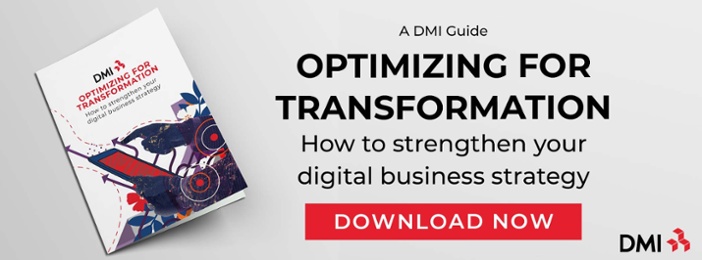
The Journey to a Modern Commerce Platform: A Guide
Even when a commerce enterprise isn’t looking at extreme platform challenges, the solution used to power this crucial part of its business could be slowing down innovation or hampering its ability to effectively compete at scale in the marketplace.
This creates a conundrum — the need to maintain a stable system for business, but at the same time, the need to modernize.
Building a modern eCommerce platform can be overwhelming. What are the factors that point toward a need for modernization? How do you choose a solution that will not only answer today’s needs, but tomorrow’s as well? More importantly, how do you get it all done?
Indicators That It’s Time to Modernize Your eCommerce Platform
A project as large and significant as updating your commerce platform might give you pause. Is it really necessary? For some, that’s a clear-cut answer. Others may need a more objective look at the ways their commerce solution may be holding them back.
On one end of the spectrum is when your current platform is being sunset. If this is the case, there is little choice: replatform, or risk working off of a solution that will be unsupported, with no new updates to features to stay competitive.
While not as extreme as a platform that is at its end-of-life, one that isn’t performant signals the need for modernization. We’ve all heard the news stories on Black Friday regarding commerce platforms that crashed, were unavailable or created errors for users. These are platforms that simply didn’t scale when needed. But performance can be more subtle and equally impactful. Up to 40% of users will abandon a site that doesn’t load in three seconds on their desktops, or faster on their phones. To put it plainly, a slow site is costing you sales — and customers.
Beyond the required and obvious reasons, there may be more nuanced reasons that can be having a significant impact on your business.
“On average, IT teams spend upwards of 40% of their time delivering updates to the front office. That’s time they could spend innovating,” says Mike “Graz” Graziano, SVP of Global Sales & Alliances for DMI’s Digital Commerce Group.
Of course, a monolithic commerce platform can be difficult to change. Even if your engineering team had the time to innovate and experiment, your architecture could be preventing you from the agility needed to remain competitive.
“You’ll know it’s time to modernize if your enterprise has a lot of technical debt,” says Spence McNeill, Alliances Director of the Digital Commerce Group. “If your current systems are too expensive to maintain or can’t move quickly enough, then you won’t be able to innovate or grow the business.”
Approaches to Commerce Modernization
Once faced with the prospect of modernization, many organizations struggle with how to accomplish it while maintaining business continuity. There are two approaches.
One is to completely change over to a new system all at once. The new platform is implemented, tested and deployed, and the old one is decommissioned. While this strategy is possible for companies of any size, it’s most feasible for small businesses.
A major shift from one platform to another isn’t doable for most enterprises, however. Luckily, iterative updates are part of the DNA of modern commerce solutions. It’s possible — and even in some cases recommended — for enterprises to take a step-by-step approach to move from their legacy commerce platform to a new one.
Of course, that requires understanding what the business needs are, laying out a roadmap, and choosing the right solution.
MACH Architecture for a Modern Commerce Platform
In DMI’s extensive experience with enterprise commerce platforms, we’ve found that a move to a MACH architecture is most beneficial. MACH stands for Microservices-based, API-first, Cloud-native, and Headless.
Microservices-Based: In direct contrast to traditional, monolithic commerce solutions, MACH architecture is made up of small, contained pieces of functionality that answer specific business needs. They are individually deployed, updated and managed, increasing the speed and agility of the business.
API-First: The functionality within a MACH architected commerce solution is exposed via API, simplifying and accelerating the ability to integrate with other applications inside the commerce platform and throughout the business.
Cloud-Native: With a commerce platform in the cloud, scalability and performance are inherent to the solution. Development and delivery can occur from anywhere, at any time, and this in combination with the first two elements of MACH means the architecture marries well with modern software practices, like DevOps.
Headless: With a headless solution, the focus is on the back-end. This frees the front-end developers to create beautiful, performant, and innovative user interfaces and functionality without being hamstrung by restrictions of the underlying architecture.
MACH creates a commerce solution that is:
- Scalable
- Composable
- Replaceable and maintainable
- Agile
- Resilient
- Secure
It also supports experimentation, innovation, and allows IT to rapidly respond to new business requirements with less risk.
Successfully Updating Your Commerce Solution
Replacing your legacy commerce solution may seem like a daunting task, even when moving to a future-proof solution like MACH. Organizations interested in doing so need to take a measured approach to the process — what are you currently doing well and where are you falling short? Then consider the business’s goals, both short- and long-term.
“Knowing where you are and what your desired state is, what the pain points are, and what’s constraining you, will help you prioritize and select a new commerce platform that meets your key objectives,” says Atul Bhammar, SVP, Solutions Architect of DMI’s Digital Commerce Group.
Next, study the market and technology space and compare it to what you currently have. Investigate the gaps and what is needed for the business to succeed on a new solution.
From there, you can begin to create a roadmap towards the modernization of your commerce platform. What best first step is needed for your organization? Is there functionality that is outdated or brittle? What changes will best serve the organization?
Most importantly, don’t be afraid to ask for help. The right partner has seen and planned the implementation of commerce solutions in a wide range of environments and with a wide range of requirements. For instance, DMI is a recognized leader helping its customers to move from legacy platforms to true MACH architecture. Companies like DMI can be that experienced trail guide to evaluate and define the path to true modernization.
If you’re looking for assistance or just have questions about how best to approach updates or re-platforming your commerce solution, DMI is here to help. Our architects are uniquely qualified to work side-by-side with you and your team to develop a solution that meets your organization’s specific needs.
